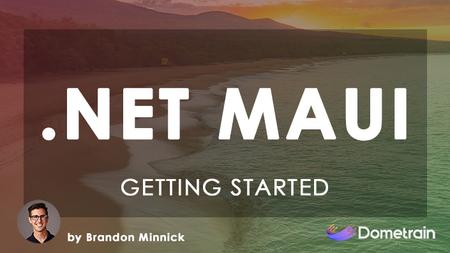English | MP4 | AVC 1920×1080 | AAC 44KHz 2ch | 59 Lessons (5h 15m) | 949 MB
Get started with building native, cross-platform desktop and mobile apps in .NET
Unlock the potential of modern app development with .NET and C# using .NET MAUI. This course provides a comprehensive look at the open-source platform .NET MAUI, which builds upon Xamarin.Forms and expands its reach from mobile to desktop. If you’ve worked with Xamarin.Forms, you’ll find many familiar aspects in .NET MAUI, along with new features and improvements. The course covers how to develop multi-platform apps using a single project structure while also addressing how to include platform-specific code and resources when necessary. Through this course, you’ll gain a deeper understanding of how to efficiently manage your app’s logic and UI layout in a unified codebase. Join Brandon Minnick for an informative exploration into the world of .NET MAUI, perfect for developers looking to get started or enhance their skills in building cross-platform applications.
Table of Contents
1 Welcome
2 What will you learn in this course
3 Who is this course for
4 What is .NET MAUI
5 Installing .NET MAUI
6 What is a ContentPage
7 Installing the .NET MAUI Community Toolkits
8 The MauiProgram.cs
9 Layouts
10 VerticalStackLayout
11 HorizontalStackLayout
12 AbsoluteLayout
13 Grid
14 ScrollView
15 Padding
16 Margins
17 What is XAML
18 XAML in Code
19 What is a CollectionView
20 Creating our first CollectionView
21 Handling CollectionView SelectionChanged
22 Using the RefreshView
23 Colors
24 What are Resources
25 What are Styles
26 Using Styles
27 Theming
28 What are Behaviors
29 Adding a behavior
30 What are Triggers
31 The VisualState triggers
32 Leveraging VisualState
33 What are Gestures
34 Adding a gesture
35 What are Application Lifecycles
36 Using the Application Lifecycle
37 The Page Lifecycle
38 Using the Page Lifecycle
39 What is Shell
40 Navigation examples
41 Creating the AppShell
42 Adding the Details Page
43 URL based routing
44 Transferring data
45 Completing the Details Page
46 What is MVVM
47 Why MVVM
48 The new Folder Structure
49 Creating the base ViewModel
50 Creating our first ViewModel
51 The Binding Context
52 Updating the List Page
53 Running our app
54 What is the MVVM Community Toolkit
55 Using the MVVM Community Toolkit
56 Fixing a weird iOS bug
57 Running our app again
58 MVVM using XAML
59 Conclusion
Resolve the captcha to access the links!
